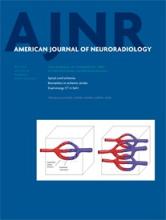Abstract
BACKGROUND AND PURPOSE: Safety analyses in the French Observatory have shown that treatment of intracranial aneurysms by using flow disruption with the Woven EndoBridge Device (WEB) is safe, with low morbidity and no mortality. The objective of this study was to analyze treatment feasibility, complications, and safety results in patients treated with the Woven EndoBridge Device Dual-Layer (WEB DL) and Woven EndoBridge Device Single-Layer/Single-Layer Sphere (WEB SL/SLS) in the French Observatory.
MATERIALS AND METHODS: Patients with bifurcation aneurysms were included in this prospective, multicenter good clinical practices study. A medical monitor independently analyzed procedural and clinical data. The study started with the WEB DL, and secondarily, the WEB SL/SLS was authorized in the study.
RESULTS: Between November 2012 and January 2014, 10 French centers included 62 patients with 63 aneurysms. Thirty patients with 31 aneurysms were treated with the WEB DL, and 32 patients with 32 aneurysms, with the WEB SL/SLS. The percentage of anterior communicating artery aneurysms treated with WEB SL/SLS was significantly higher (37.5%) compared with WEB DL (12.9%) (P = .04). The WEB SL/SLS was more frequently used in aneurysms of <10 mm than the WEB DL (respectively, 96.9% and 67.7%; P = .002). Morbidity was similar in both groups (WEB DL, 3.3%; WEB SL/SLS, 3.1%), and mortality was 0.0% in both groups.
CONCLUSIONS: This comparative study shows increased use of WEB treatment in ruptured, small, and anterior communicating artery aneurysms when using WEB SL/SLS. There was a trend toward fewer thromboembolic complications with the WEB SL/SLS. With both the WEB DL and WEB SL/SLS, the treatment was safe, with low morbidity and no mortality.
ABBREVIATIONS:
- AcomA
- anterior communicating artery
- DL
- Dual-Layer
- SL
- Single-Layer
- SLS
- Single-Layer Sphere
- WEB
- Woven EndoBridge Device
- © 2015 by American Journal of Neuroradiology












